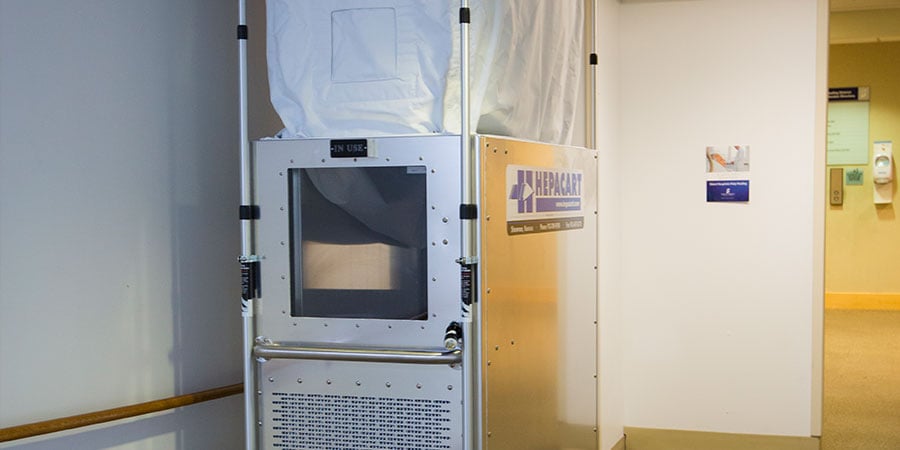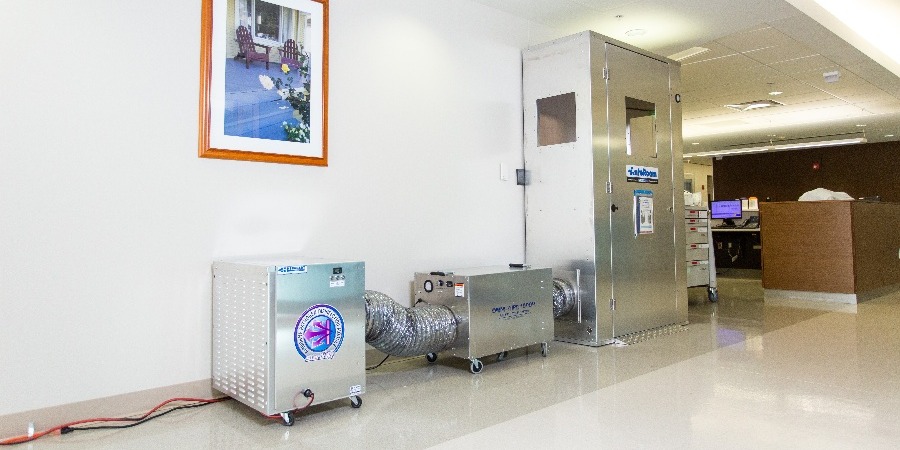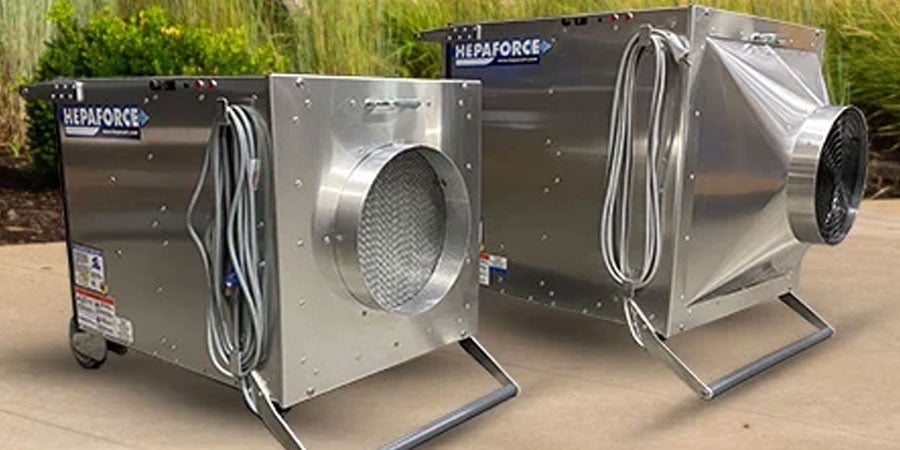Share this
How HEPACART® Revolutionizes ICRA Containment: A Comprehensive Guide
by HEPACART on Jan 22, 2024
.png?width=900&height=450&name=Blog_ConstructionPlanning%20(1).png)
Health and safety are the absolute top priority for medical centers around the globe, however, a commitment to keeping your facility healthy goes far beyond clean surfaces and protective equipment. Your healthcare facility is responsible for the well-being of patients at all stages of life and with all sorts of ailments and medical conditions. You don't want to take any chances when you’re tasked with their physical health. During construction and renovation activities in your facility, this responsibility can be more difficult to manage with higher dust levels, construction debris, and an increased risk of infection. To maintain health and safety standards, facilities must stay current on their infection control strategies as well as select tools and equipment that will support their commitment to a healthier environment.
We understand the pressures that your facility faces day in and day out, and that’s why HEPACART is here to change the game in ICRA (Infection Control Risk Assessment) containment within healthcare facilities. If you're in the thick of planning or managing healthcare construction or renovation, you already know the importance of keeping your environment safe.
The Power of ICRA Containment
ICRA containment is all about understanding and managing the impact that these projects have on air and water quality, and ultimately, patient safety. It guides construction teams through critical questions, like assessing the potential impact of a project and finding the safest ways to navigate it. Let’s dive in and explore how HEPACART tools and strategies can help you achieve your goals while adhering to these essential safety standards.
ICRA 101: Keeping Your Team In the Know
When you’re managing safe indoor air quality and infection control practices in your facility, you’re not doing it alone. The key is to make sure that everyone — construction crews, medical staff, facility teams, etc. — is aware of ICRA practices, protocols, and standards. It’s impossible to expect the highest safety standards if not everyone is on the same page. While formal ICRA training for everyone on your team is the gold standard, there are a few questions that you can educate your crew about before you begin any construction or renovation project.
Understanding Dust Containment
In the healthcare setting, it’s crucial for your crew to first understand what dust containment is; the capturing and limiting the spread of dust particles. This may seem simple, but when construction crews are sanding, knocking down walls, climbing into ceilings, etc., there is a high probability that potentially dangerous particles can be disturbed and wreak havoc on sensitive patient populations.
While not everyone needs to memorize every ICRA guideline or track Air Changes per Hour (ACH), a basic understanding is essential. What activities create the most dust? What are practical ways to limit the spread of debris? The more functional knowledge that you can provide, the better off your ICRA compliance will be.
Why Dust Containment is Important
It’s one thing to give your construction teams a to-do list, but it’s much more powerful if they understand the impact of why they should prioritize dust containment. After all, knowledge is power. Dust containment helps to keep patients, staff, visitors, and everyone else in a medical facility safe from harmful particles. The better your construction crew and facility management teams understand this, the more likely they are more likely to remember and implement it effectively.
Which Projects Require Dust Containment
Every project is different, and not all tasks will require dust containment strategies. If your team is educated on how and when to use ICRA dust containment procedures, they’ll be able to keep construction sites safer, but they’ll also be able to save time and money by deciding which projects don’t require the same level of intensity with dust containment practices. The longer that your teams work in the ICRA framework, the more familiar they will become with addressing different types of jobs and handling each of them appropriately based on the potential risk level.
How to Use Dust Containment Tools
Possibly the most important element of a successful ICRA strategy is ensuring that your crew is not only informed but also practically trained on the operation of dust containment equipment. It’s one thing if they know that they should use a dust containment cart or a negative air machine, but it’s another entirely to know how to use these machines effectively. For some, minimal direction is required, but for more complex setups, you’ll want to provide training and guidance around maximizing your equipment and its functionality.
ICRA Requirements: Before, During, and After
As the facility manager, it is your responsibility to ensure ICRA guidelines are correctly planned for and implemented, including every stage of the maintenance process. ICRA compliance is not a one-time deal. To prioritize safety in your facility during even the most invasive construction projects, it’s an ongoing process to establish infection control and dust containment strategies, monitor their status, and evaluate the results through the end of a project.
Here are a few guidelines for each step of the way:
Before the Project
First, designate which physical areas of your facility will be impacted by construction or renovation activities and which will not. This is also the stage of the process when you will want to purchase or source equipment like a HEPA filtration unit to maintain good air quality and filter resulting dangerous particles from the air.
During the Project
As progress begins on the construction or renovation, make sure that the appropriate ICRA guidelines are being observed and that any equipment is used and maintained properly. You’ll also want to keep an eye on key metrics like Air Changes per Hour (ACH) and others that will indicate if Indoor Air Quality (IAQ) standards are being met.
After the Project
Use this opportunity to evaluate how well your facility, construction teams, and medical staff did to support ICRA standards throughout the process. Were there any areas that could be improved upon for future projects? Take this time to assess any areas of growth and plan for further training or education for future construction endeavors.
How to Follow ICRA Steps Effectively
Meet With the Construction Team Regularly
Regular meetings with the construction team are crucial for ensuring safety. As a facility manager, it’s your job to clearly communicate expectations and build confidence within the team. This continuous dialogue helps maintain adherence to safety protocols.
Ensure Everyone Knows and Understands the Assessment Structure
It's important to ensure that all involved parties, including hospital staff, construction teams, and maintenance workers, are aware of and understand the ICRA standards and guidelines. Effective communication of these processes is key to ensuring everyone is on the same page and working towards a common goal of safety and compliance.
Perform Constant Infection Control
Infection control must be an ongoing priority throughout the project. This involves modifying HVAC systems as needed and utilizing barriers and negative air machines to control the spread of airborne contaminants. Staying vigilant is essential to protect sensitive areas within your healthcare facility.
Communicate With Staff and Keep Them Up-to-date
Keeping all staff informed about ongoing maintenance projects is essential, especially since these projects can vary greatly in size and scope. Regular updates and communication ensure that everyone is aware of the current situation and any necessary safety measures they need to follow.
The Gold Standard in Compliance: HEPACART ICRA Containment Equipment
Your infection control strategy is only as good as the equipment you choose to support your ICRA compliance. Thankfully, we’re committed to bringing you and your facility the highest quality dust containment and infection control products to prioritize health and safety in your medical center. Depending on what your specific needs are, there is a HEPACART product that is right for you.
The HEPACART® Classic

The HEPACART Classic is a practical and efficient mobile unit designed for dust containment, particularly during construction or renovation projects in healthcare settings. It's built to ensure compliance with ICRA Levels I-V, focusing on trapping and securely locking away dust and other airborne particles.
The AnteRoom Classic

The AnteRoom Classic is an innovative, temporary room isolation module, ideally suited as an entryway or vestibule for rooms undergoing maintenance, renovation, or construction. Use it on its own or paired with a negative air machine to boost its infection control abilities.
HEPAFORCE® AIR Negative Air Machine & Scrubber

The HEPAFORCE® AIR Negative Air Machines & Scrubbers are versatile and powerful air purification tools. These machines powerfully clean the air and are capable of establishing either positive or negative air pressure, which is crucial in areas affected by mold, asbestos, lead, or other contaminants.
Excellence in ICRA Compliance with HEPACART
If you're navigating the complexities of ICRA containment and looking for solutions tailored to your facility's needs, we're here to help. Whether it's understanding the nuances of dust containment, enhancing your infection control practices, or selecting the right equipment, our team at HEPACART is committed to supporting your goals for a healthier, safer healthcare environment.
Let's discuss how our products can fit into your ICRA containment strategy and help you uphold the highest standards of patient care and safety. Contact us today to set up a meeting and explore your ideal equipment lineup.

